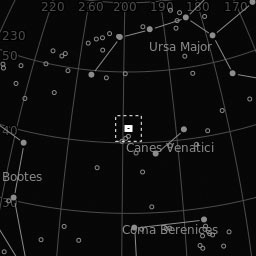
M 63
Spiral galaxy in the constellation canis venatici.

Spiral galaxy in the constellation canis venatici.
Messier 63 (also known as NGC 5055) is a spiral galaxy with the apparent brightness of 8.5 mag in the constellation Canes Venatici. The object, also called sunflower galaxy, is about 24 million light years away from the solar system (30 or 37 million light years depending on the source).
| Object: | M63 |
| Date of exposures: | 01.05.2017, 01.04.2018, 05.04.2018, 06.04.2018 |
| Distance: | 24 Mio. Lightyears |
| Exposures: | L: 94 x 300", 190 x 60", RGB: 72 x 360", Sum: 18,2 hrs. |
| Telescope: | 10'', F4 Newton |
| Focal length: | 1000 mm |
| Filter: | Astrodon RGB E-Series, Astronomik CLS CCD Filter |
| Camera: | Atik 460Exm |
| Guiding: | Off Axis Guider, Lodestar |
| Mount: | EQ8 |
M 63 has a diameter of 50,000 light years (or 65,000, depending on the source). Unusual and name-giving are the many nodular densifications in their spiral arms, which are star formation areas and shining gas clouds.
In this very long exposed image, a star stream in the form of an arc extending 14 arc minutes and only 1.6 arc minutes wide becomes visible.
A detailed study by Taylor S. Chonis and others concludes that a dwarf galaxy with around 100 million solar masses was swallowed here. The tidal interaction during rupturing also produced the still visible, wide star stream.
The very bright central region of M 63, which extends over around 1,000 light years, surrounds an active core and surpasses its ambient brightness by a factor of six, in H-alpha light by a factor of 25. The rotation speeds measured here suggest a central black hole of almost one billion solar masses.
The object was discovered on 14 June 1779 by Pierre Méchain.